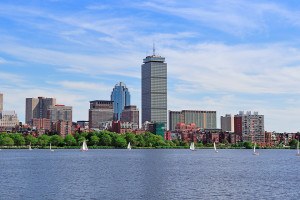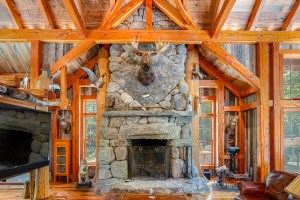Steven Samuels Is Fenway’s Man with the Golden Charm
How developer Steven Samuels transformed the Fenway from a dump into a destination.
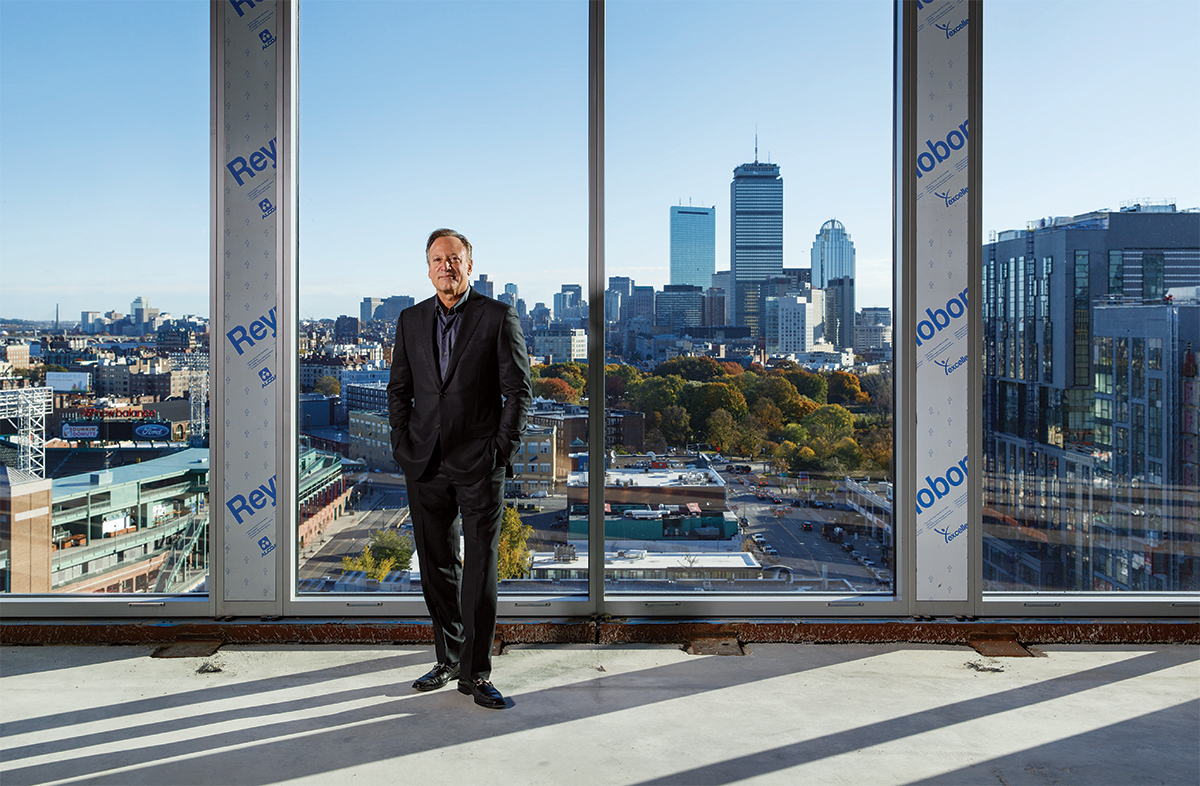
The view’s just dandy from the Van Ness, Samuels’s third major Fenway project. Photo by Bob O’Connor.
It’s a white-hot august morning and Steven Samuels and I are dodging the sun in the courtyard of his new Verb Hotel, on Boylston Street. It feels very Hollywood, as this low-slung, ’50s-modern edifice sparkles from reflections off the backyard-size pool. Samuels looks every bit the middle-aged movie mogul in his Varvatos taupe polo shirt, collar spread wide. Something you’d see on Sinatra or Dino, tucked into high-waisted, triple-pleated slacks. His hair does a single smooth wave off his high, lineless forehead. Call it L.A. Casual East. A few steps away, his 10-year-old daughter lounges listlessly like a jaded star, occasionally interrupting us to announce that she’s bored or that Mom’s on the phone or to remind him that they still don’t know who they’re taking to the One Direction concert.
That we’re standing here, at street level, squinting into each other’s sunglasses, shouting over rock tunes piping in from the Verb’s outdoor sound system, defies all real estate logic. By the laws of urban development, we should be at least 10 stories up, gawking at the view—looking directly into Fenway Park—from some carpeted and air-conditioned hotel conference room.
Because chances are this squat, low-bed-count boutique hotel—close enough to the ballpark that a minor league hitter could lob one over the wall right onto the infield from the valet lane—isn’t making a dime.
That’s not anything Samuels needs to worry about right now—he owns half the neighborhood. Just as he’d hoped, the Verb has been glowingly written up in the Globe and the Wall Street Journal as a tribute to the area’s rock ’n’ roll roots, with every detail of the interior reflecting a glamorized version of a Fenway neighborhood that never really was. There are enshrined pieces of the Rathskeller (that demolished Kenmore dive where Boston’s punks discovered sonic distortion and Colombian coke), as well as ephemera from WBCN (the radio station that broadcast the soundtrack of Boston’s counterculture). Every room sports reproductions of the late Boston Phoenix’s lefty sloganeering; a rack of LPs in the lobby can be played on the accompanying Realistic turntable; and Fiji water–filled fridges are disguised as Marshall amps.
From a jaundiced standpoint, the Verb stands as a highly stylized symbol of an invented Fenway—a stage set, a prop, part of an elaborate marketing plan designed to sell us on an entirely new neighborhood sprung from what has been, for half a century, a wasteland of parking lots, gas stations, and tire stores.
But the Verb and the new Fenway also tell a story about how to amass power in the most elegant of ways. Since acquiring his first Fenway properties more than 14 years ago, Samuels has united the neighborhood’s middle-class residents with top-tier financiers and the city’s notoriously fickle bureaucracy to arrive at a workable vision of what this dump of a place could become.
At the center of the tale is Samuels himself, a quiet multimillionaire who rarely speaks publicly, shuns the spotlight—and has charmed his way into a massive, 18.4-acre kingdom of prime mixed-use property in the heart of the city. No other developer in recent memory has come into Boston quite like this, taking over such a huge landmass in such a short time, utterly transforming a neighborhood so close to downtown into something completely unrecognizable. How Samuels did it involves money, ambition, patience, and, quite frankly, alchemy.
Already, the tent posts of Fenway’s revival are on display. At 180 Brookline Avenue, there’s a million-square-foot development called Fenway Triangle Trilogy housing 405 luxury apartments, restaurants like Tiffani Faison’s barbecue joint Sweet Cheeks, and retail including a West Elm and a Starbucks. Across the street, another Samuels development called Van Ness is under construction: It takes up an entire city block, anchored by an enormous CityTarget. It also has residences and 237,000 square feet of new office space—a six-story slice, four stories up, creates a sliver of landscape that will divide the glassy housing tower from the glassy office tower. Around the corner is his hulking 952,000-square-foot Landmark Center, with a movie theater, restaurants, and more office space. Samuels is installing a Wegmans on the ground floor, à la Chelsea Market, and adding three new 10- to 12-story apartment buildings—500,000 square feet of new build that will overlook a verdant rooftop park.
If someone had pitched this idea 20 years ago, no one would’ve bought it. Back then, the land was broken up into dozens of separate properties owned by entities large and small, from the Red Sox to recent immigrants. Turning around the neighborhood seemed all but impossible. For one thing, the city’s zoning rules prevented anyone from building higher than a few stories. And the Red Sox seemed to like it that way—it guaranteed that nothing would interrupt the sightlines around Fenway Park, which loomed over all, belching out drunken fans into the streets for six months a year. The all-powerful Sox had insulated themselves from their neighbors—Boston University to the north, Northeastern University to the south—with a cocoon of garages and gas stations. Why mess with success?
So Samuels took his time. He watched and waited, slowly synthesizing a story from all the chatter, which he then used to convince everyone that he could birth a neighborhood. He repeated that same story to owner after owner to coax them into letting go of their lucrative Boylston Street addresses. And he scaled the Mt. Everest of municipal bureaucracies to get the neighborhood rezoned to heights that made development worth pursuing.
That’s not, historically, how Boston has done urban development. Too often, change happens contentiously, with neighborhoods battling developers, and the city—in the form of the Boston Redevelopment Authority—serving as referee. Sometimes developers throw the people a bone, giving them parks or conceding a few feet in height, in the hopes that they’ll shut up. Sometimes the neighbors are roundly ignored—especially when the developer’s interests and the city’s are closely aligned. Rare is the developer who has any interest in the long game—one that involves a decade of endless meetings and a rapidly moving bottom line. That’s a game for losers.
Or Steve Samuels, who asked of all, Don’t you want to be part of something big?
And holy hell, is it big: A lot of money is riding on this new Fenway. We’re talking billions—J. P. Morgan money, family money, foreign-investor money, and, through tax breaks, city and state money. But sometimes big bets pay off really big. And I want to get inside the mind of the high-rolling, patient gambler.
Real estate makes strange bedfellows, and this is a story about one odd pairing. Steve Samuels needed to buy a gas station, and the owner, George Pagounis, knew it. Though the Texaco station occupied a mere 100 feet along Boylston Street—just another eyesore among eyesores in the Fenway—to Samuels, it was a crown jewel, a holy grail, the final piece of a property puzzle he’d assembled through years of negotiating with owner after property owner. Without the Texaco, he couldn’t build the 550,000-square-foot superblock of offices, apartments, and retail, known as Van Ness, that he’d been planning for years.
The Pagounis family had already met one suitor. “Someone from the Red Sox came over, very obnoxious,” says Stratton Pagounis, George’s fiftysomething son. “He says, ‘Boy, do I have a deal for you. This property’s worthless, it’s a postage stamp. I’ll give you one million dollars. You aren’t going to get more than that from anybody.’” When Stratton went back to his father with the offer, George’s response was two words: “Shoot him.” The Sox guy came around a few more times, “wanted to meet again and again,” Stratton says, “and I said, it’s not for sale. I wouldn’t sell it to you for anything.”
Empire-Building
Between 1999 and 2013, Samuels & Associates bought 18.4 acres in Fenway in more than a dozen transactions.
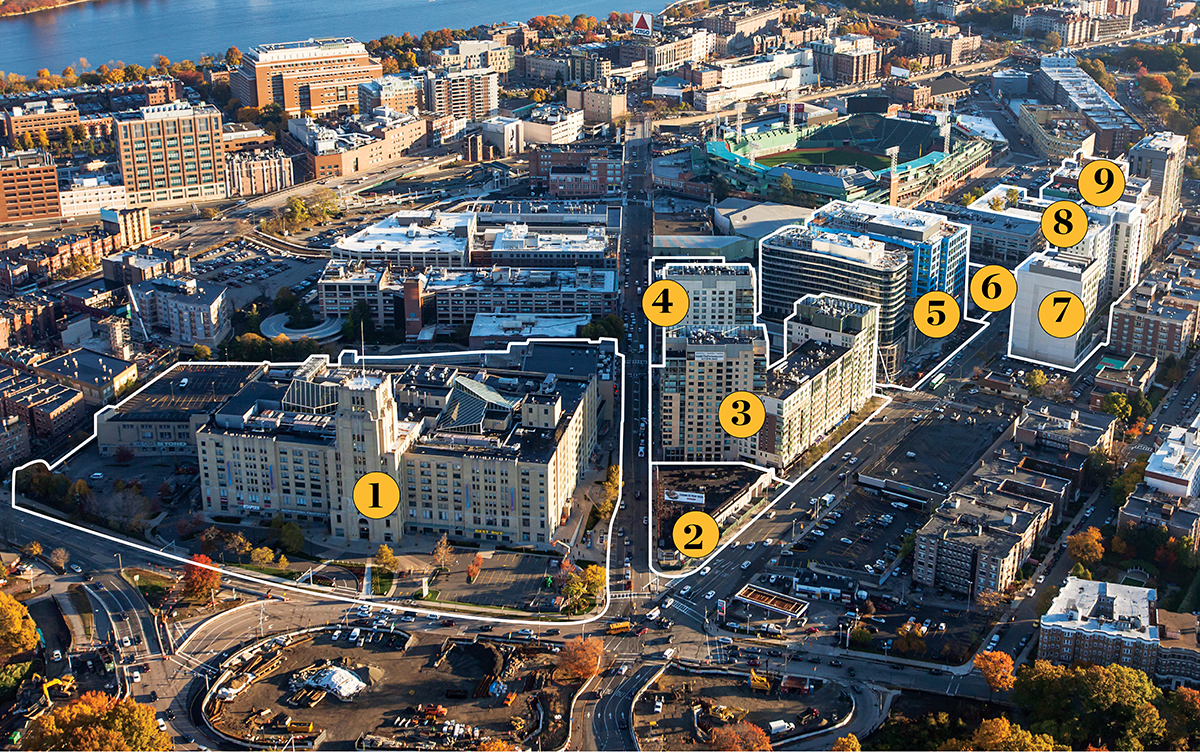
photograph by pj couture
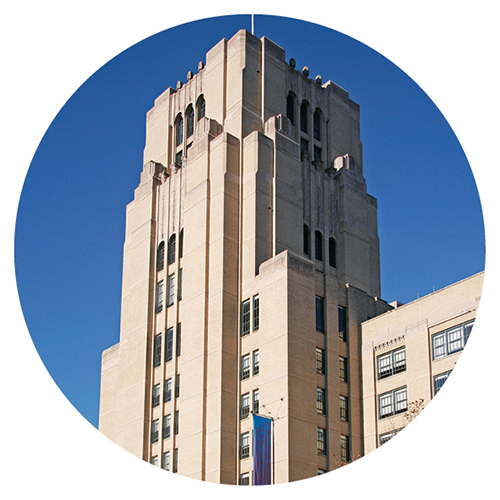

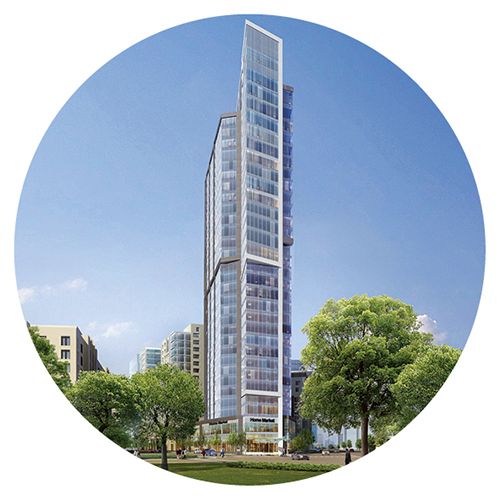

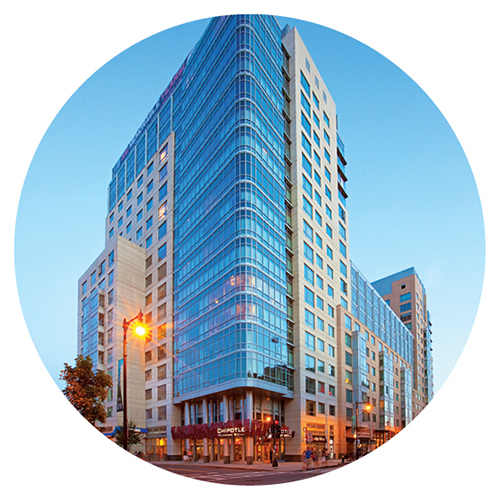

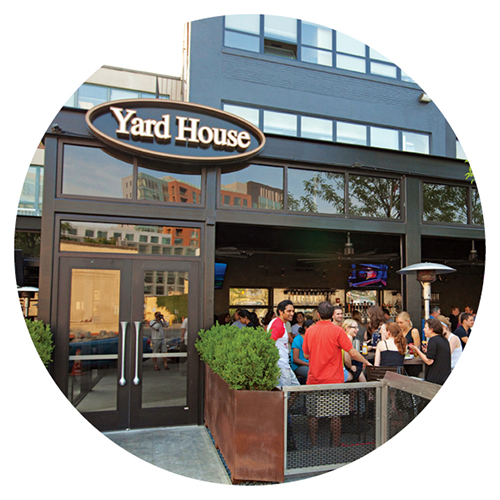

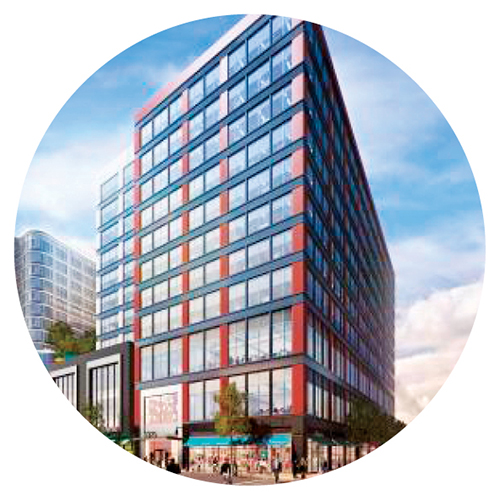

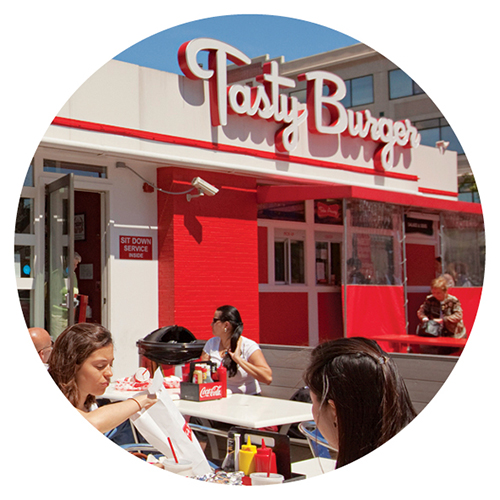

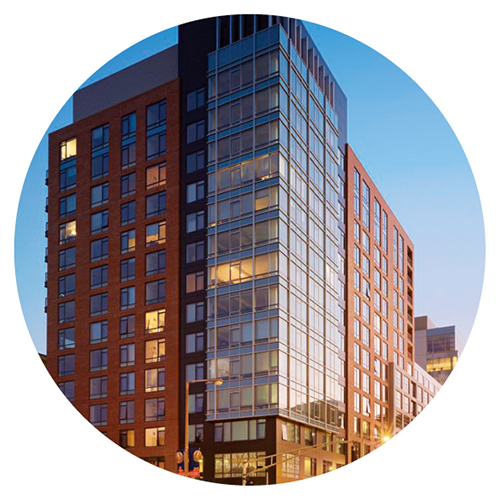

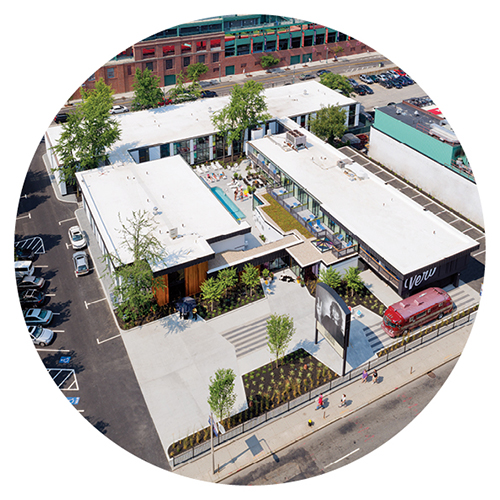



Then Samuels showed up. “I’ll tell you the truth,” Samuels told Stratton. “I need this [property]. You can really bust my balls, but I need you.” He was firm, but dead honest. “Samuels said, ‘I want it. I need it. Give me a price, let’s work it out.’” Samuels’s straightforward approach made him instantly sympathetic. “I trusted him the first day,” Stratton says. (Stratton isn’t exactly the trusting type: Once, while at a dinner meeting with Samuels, Stratton solved the question of who’d pick up the tab by pulling out a .25-caliber Beretta. Needless to say, he prevailed.)
Though Stratton and Samuels hit it off, it took a year of negotiating to reach a deal—and even then, it very nearly fell apart. After shaking hands on a price, Samuels and Stratton found themselves in a conference room at the Pagounis family’s lawyer’s office. They were sitting face to face with Stratton’s father, George. It was like the final round of some kind of obscenely high-stakes poker game, and even though he was surrounded by heaping piles of chips, George looked miserable.
George Pagounis had come from Greece with nothing, had built up his gas station empire and never, ever sold a thing. It was time for one, final epic maneuver. “My father goes, ‘Wait. No,’” Stratton recalls. “We’re all looking at him. He goes, ‘No, no, no, no, no. I want an extra $400,000.’ You shoulda seen Steve’s face drop. He looks at me, and I go, ‘I don’t know.’ Steve goes, ‘Okay, we’re done.’”
Outside the meeting room, George let loose on his son. “I go, ‘Yeah, I think it’s fair,’ and [my dad] goes, ‘Shut the fuck up.’ I thought the deal was more than fair, but we didn’t push him, you know?” Eventually, George Pagounis returned to the table. Now he wanted even more—an extra $600,000. Samuels finally agreed. Even though he’d been taken to the cleaners, he’d done what nobody else could do: He’d gotten a yes from a man who’d sworn never to sell.
Stratton adds, “My dad still says to this day, ‘You know why I don’t like you? You nearly cost me half a million dollars.’”
As we chat in the verb courtyard, Samuels tells me that growing up in Cleveland, he dreamed of playing three-chord classic rock ’n’ roll like his heroes, the Michael Stanley Band. Okay, you’ve never heard of them, but they were big in Ohio in the ’70s, he assures me. Samuels spent most of his youth in front of giant speakers, hanging with John Cougar, back before he was John Cougar Mellencamp. “I’d sit at the bar drinking with him until he went on. He had this little, like, hairdo, his leather jacket and his leather collars up like this,” he says. “He was like really such a bad-ass before punk was punk.” I try to picture Samuels as a teen, but I can’t.
Hanging with Cougar, listening to blue-collar rock, Samuels developed an easygoing, guy-on-the-barstool manner that served him well in his family’s lucrative real estate business. His great-uncle Julius Kravitz was the owner of the family company, First National Supermarkets—a group of several supermarket chains and shopping centers—which he’d grown into a billion-dollar consortium, making him, by 1979, one of the richest men in Cleveland. Tragically, that also made him a target. One evening, Kravitz and his wife were abducted from their apartment by two men, one posing as a cop. In the ensuing madness—the abductors drove the couple around town attempting to collect a ransom—Kravitz’s wife leaped from the car and escaped, while Julius was shot several times. He died of his wounds. The murderers were caught, but one of the abductors spent time in a mental hospital and, 14 years later—following a series of controversial court hearings—was eventually released.
After Kravitz’s death, Steve’s father, Robert Samuels, took over the New England real estate division of the company and moved to Connecticut in the early ’80s. He sold the company to a Dutch entity in 1988, but still likes to keep busy. His friends include the Wegmans family and fellow billionaire developer Stephen Karp—the reason Samuels family vacations tend to happen on Nantucket.
Steve graduated from the Ohio State University in 1981 and joined his dad, overseeing acquisitions and managing properties. Robert taught his son that controlling land was more lucrative and less troublesome than running supermarkets, so Steve Samuels pursued real estate development, starting with a Bridgeport, Connecticut, shopping center in 1986. He was 26 years old.
Today, the Samuels family has interests in at least 80 shopping centers around the country. And Steve still has populist tastes: He owns toy trains and a Harley; he recently kicked an Oreo habit, and he likes to destress by hiking in Maine and New Hampshire. He lives in a $7 million, 8,000-square-foot Brookline manse with his wife, Ami Cipolla. The couple, who met at a shopping-center convention in Las Vegas and married in 2002, have three children. “Development is a very comfortable business,” Robert Samuels tells me when I get him on the phone in Connecticut. Then again, what Steve is doing is “much more innovative than what I did,” he says. “I’m kind of amazed at it.”
But right now, as we stand around the Verb’s courtyard, Samuels shifts gears from real estate to moviemaking, which he claims are essentially the same business. His voice has a hoarseness earned from years of storytelling, but he’s not a gesturer—his hands stay down. In his first attempt as a producer, Samuels tells me, he’d bankrolled the 2006 Demi Moore comeback vehicle Half Light, which resulted in a mess of lawsuits, bad weather, cranky movie stars, and a key financier’s fatal heart attack. “So I start to film and everything that could go wrong goes wrong,” Samuels says. “It was so bad, I was personally sick every night…. Instead of doing my real estate business I’m on the phone every day all day. I’m putting film stock on my credit card every night because they don’t have money.”
I suggest that smarter guys would have said, Screw that business, but in very typical Samuels fashion, he insists with an easy smile that the entire ordeal was merely a very expensive “900-level course” on movie producing. “The whole story there is that out of pain, disaster, and screwing up,” he says, “I got a chance to get involved with the right people.” Eventually, it paid off: He produced, among others, In the Valley of Elah, the Paul Haggis film starring Tommy Lee Jones, and the George Clooney vehicle Michael Clayton, which was nominated for seven Academy Awards and won one. As the Los Angeles Times pointed out, Clayton would not have been made if not for Samuels, who “bankrolled the project when no studio would put up the money.” Samuels has since cofounded a New York–based movie company, FilmNation Entertainment, which continues to produce indie films while managing international distribution for major motion pictures, which is, frankly, where all the film money is right now.
Just as we start circling in on what it’s like to hang with Clooney, something he really doesn’t want on the record, Samuels artfully changes course. Meanwhile, he’s constantly reading me to make sure I’m engaged. And I am. “Have you heard my rat story?” he asks.
Last February, Samuels bought a vintage 1947 Greyhound-esque luxury bus, the size of a dining car. He found it in one of those classified-ad rags you see at convenience stores, and drove it down from Maine to the site of the Verb, on Boylston Street. The Verb was under construction then, and when Samuels walked off the bus, he encountered a hawk eating its dinner in the middle of the courtyard. “He’s like this big with his wings out and he’s got a rat half-eaten in his mouth,” Samuels says. The hawk tried to fly away and smashed into the glass on the other side of the courtyard. Samuels thought it was dead. “Out of nowhere, the hawk flips over onto his feet, pukes up the rat, looks back at us.” Then, he tells me, he got the hell out of there.
On the face of it, Samuels is merely showing how the hotel—and the neighborhood—were like the Serengeti over here on Boylston. But what he’s really telling me, I think, is: I’m still the same punk-ass kid who loves rock ’n’ roll. It’s all so effortless. Which is why I have to keep reminding myself, as we chat on this lazy, blue-skied morning in the L.A.-style Verb, that although he’s not into chest-thumping and we’re talking movies and rats and vintage buses, Samuels is the clever son of a bitch who slipped this property, and practically the entire Fenway, right out from under everyone’s nose.
In the 1950s, the Fenway was booming—with traffic. The city had paved over parts of the Emerald Necklace, creating a tangled nest of asphalt and urban highways. Boylston Street was the major artery serving the Longwood Medical Area to the west, and the Fenway’s two commercial anchors: Fenway Park to the east, and, since 1929, Sears, Roebuck & Company’s massive, 9-acre distribution complex to the west. (Built at the intersection of Park Drive and Brookline Avenue, it’s now the sprawling Landmark Center shopping and office development.) Sears’s army of delivery trucks clogged up Boylston, which was already choked on game days, cleaving the Fenway into a light-industrial north and a primarily residential south.
As Boylston Street became a virtual shrine to all things automobile, a young developer named Robert Sage realized, in 1959, that the only thing the Fenway lacked was a good motel. That year, he built his first project, the Fenway Motor Inn—a completely of-the-moment international-style motel, surrounded by open parking—just a base path away from the south wall of Fenway Park. Sage, the son of legendary New England bookie Harry “Doc” Sagansky—and the sister of Boston’s most storied fashionista, the late Marilyn Riseman—built buzz for the motel by booking rooms for mob-circuit stars like Connie Francis, Jerry Vale, and Tony Bennett. Occasionally, some of those stars would perform at the motel’s VIP lounge—the same one where, Howie Carr wrote in the Herald, Doc Sagansky settled his books every Monday “with a wad of cash that would choke a rhinoceros.”
